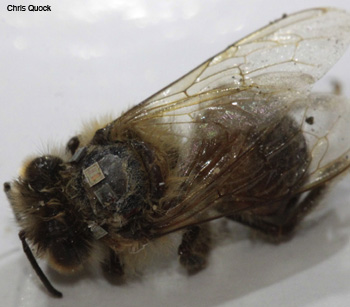
Bees tagged with RFID chips pass through a laser beam at the hive’s entrance. Their chips absorb optical power and emit a unique signal that indicates if they are entering or leaving the hive. Researchers hope this will show how zombie bees act before they leave the hive for the last time.
In an attempt to determine whether zombie bees act differently than healthy bees, Chris Quock of San Francisco State University (U.S.A.) is tracking individual bees using an ingenious system with lasers and tiny radio-frequency identification (RFID) chips.
A tiny parasite that "zombifies" honey bees, altering the behavior of the hosts, was reported at San Francisco State last year. The researchers found that infected bees left the hive at night to congregate near outside lights, moving in increasingly erratic circles on the ground before dying (PLOS ONE, doi:10.1371/journal.pone.0029639).
But "what, if any, changes happen to the bee between being infected with the parasite and abandoning the hive?" asks Quock. Tracking individual bees as they come and go from the hive would help answer the question. But the problem with tracking them, explains Quock, "is that bees all look the same." A previously used method of attaching tiny plastic labels to the bees still requires that someone sit and watch the bees—and even then, the tags are easy to miss.
Attaching active labels to the bees is problematic because they require a power source, which makes the whole bundle larger and may interfere with the bee's typical routine. Instead, Quock glues tiny passive RFID chips to the top and sides of the bee's thorax and uses lasers to power the RFID chips as the bees crawl into or out of a hive. The light-powered microtransponders, about the size of a piece of glitter, are made by Pharmaseq and were developed for use in biotech labs. A low-power red diode laser illuminates the chips, providing enough energy so that it can broadcast a radio-frequency identification to the nearby detector.
By using two laser/radio-frequency detector systems, the researchers can gather data on whether a tagged bee is entering or exiting the hive. The system offers a 24-hour bee monitoring with fewer people. Quock is in the process of gathering data and won't be ready to publish results until 2013 or later. Other researchers on the project include Quock's advisor, Andrew Zink; Chris Smith; John Hafernik; and bee keeper Robert MacKimmie.
Meanwhile, the researchers are watching for further signs of the mysterious parasite and encouraging the public to participate through a new website www.ZomBeeWatch.org.
